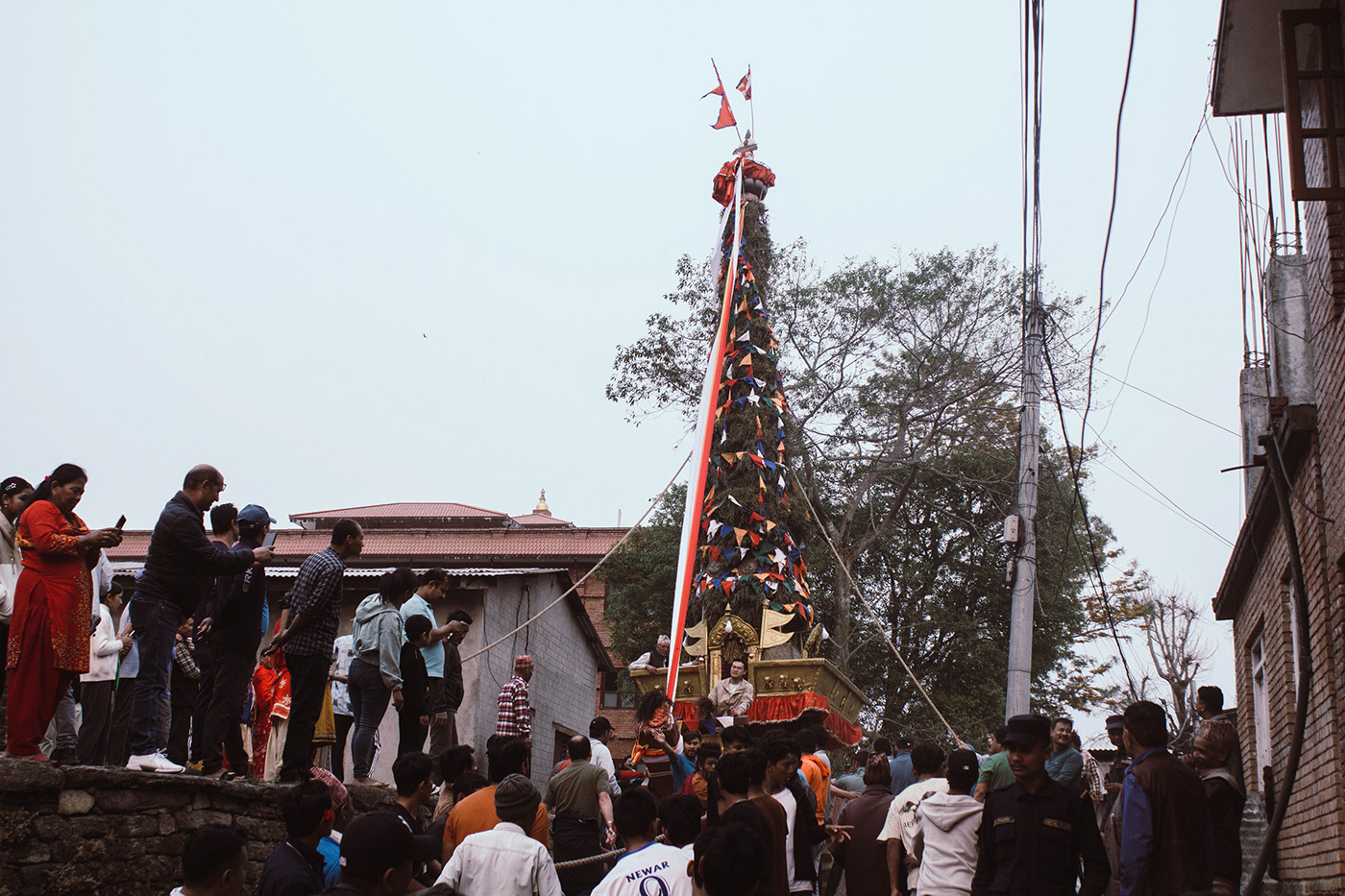The procession of Rato Machhindranath, revered as the deity of the era, in the ancient city of Dolakha

Buṅga Dyaḥ, also known as Raktalokitesvara, Karunamaya, and Rāto Machhindranāth, is revered as the god of rain and the provider of grains. The name Rato Machhindranath signifies "Red Machhendranath," reflecting the deity's image color. The chariot festival's timing varies as it follows the lunar calendar, commencing on the 4th day of the bright fortnight of Bachhalā, the seventh month in the lunar Nepal Sambat calendar.
During the reign of King Narendradev in Nepal, a severe drought afflicted the people. Acting upon the counsel of learned scholars, in the year 3673 of the Kaligat era (632 BS), Kamrup Peeth brought Machhindranath (Matsyandranath) from Assam, India, to ward no. 22, Bungmati, where it was enshrined. This deity is also revered as the god of rain and the benefactor of the people.
An annual celebration marks the deity's entry into Nepal, observed with the Rath Yatra tradition in Lalitpur. Machhindranath is venerated by both Hindu and Buddhist communities. Approximately 943 years after the compassionate deity Avalokitesvara Machhindranath entered Nepal, a historical account narrates its arrival in Dolakha in the year 1575.



During the period when Dolakha was transitioning to an independent state, King Nandadev Singh, assisted by Mahagurudev Bajracharya of Patan, oversaw the construction of the Red Machchindranath statue in Bungmati. Historical records from Nepal Sambat 639 (1575 BS), specifically on Baisakh Sudi 17 Shukla Paksha Trayodashi, indicate the building of a temple in Dolakha's Dwakalunga tole using traditional techniques.
This is why the deity Machhindranath is referred to as Bugdeu in the Dolakhali Newari language. Rituals include Puja Bhajan with milk on Chaitra Purnima, followed by the placement of Pingal on the chariot the next day, Pratipada. While Dolakha's chariot may not match Lalitpur's in size, it is adorned with symbolic representations filling a space not less than 32 feet. Bajracharya Gubhaju performs the Lord's worship after placing him in the chariot, while Bhairav, in the form of a snake, is worshipped by Guthiyars of noble families (Pingals) who offer sacrifices.




The collapse of the Machindranath chariot during its procession is viewed as an ominous event, thought to herald unfortunate consequences for the nation. In 2001, before the Royal Massacre, a similar incident occurred with the chariot of Seto Machhindranath. Such occurrences carry symbolic weight, suggesting a disruption in the natural order and potentially signaling tumultuous times ahead. The belief in the significance of these events reflects the deep-rooted spiritual and cultural beliefs of the community. The chariot procession is a sacred ritual, and any disruption to it is interpreted as a forewarning of societal upheaval or calamity. The fall of the chariot is seen as a sign from the divine realm, prompting introspection and precautionary measures to avert adversity.
It serves as a reminder of the interconnectedness between spiritual beliefs and societal events, emphasizing the importance of maintaining harmony and reverence in religious practices. The reverence for Machindranath and the symbolism associated with the chariot procession underscore the profound impact of cultural traditions on the collective consciousness of the people, shaping their perceptions and responses to unfolding events.

Before the commencement of the Rath Yatra of Machhindranath, villagers designated for the task perform a ritual known as Tolpuja. Basudeva, the younger brother of King Indrasingh Dev in Dolakha, played a role in organizing the Rathayatra of the revered Avalokitesvara Matsyandranath during the years 1630-1633.
During this time, lands in Lapilang, Leptung, and Kartike were entrusted to the Thami community by the Guthi for cultivation. The Thami, along with artisans responsible for crafting chariots, would gather ropes, garlands, and other necessary materials for chariot-making. This tradition of Rath Yatra, which has persisted for centuries, continued from the year 2039 onward. However, for about fifteen years, a modified version called Khatyatra replaced Rathjatra. Eventually, the local social organization Kalinchok Youth Club, with assistance from the community, constructed a new chariot, leading to the resumption of Rath Yatra from the year 2055.
An anecdote regarding the Machhindranath chariot journey recounts a man hearing the sound of clothes being washed in the three-tier Rajhiti one night near Rath Yatra time. Investigating, he found a ghostly washerwoman, whose gold-studded clothes he stole, leading to a custom of displaying them. Another incident pertains to the chariot procession, previously not taken uphill to the upper village but directly from Tasichha tol to Dungal tol. Once upper village residents managed to bring the chariot uphill, they were honored with gold garlands, prompting lower village residents to attempt the same on a steep hill.




The origins of the Machindra Nath Rath Jatra in Dolakha remain shrouded in mystery, with historical researchers yet to uncover its initiator. However, evidence dating back to 1638 AD suggests the presence of significant relics, such as the survan prabha and umbrella offered by monks of Omvahal, indicating an early association with the Thami caste.
Regarding the deity honored during this distinctive journey, Dolakhali Hindus regard Gorkhanath as Guru, Loknath, Karunamay, Adinath, and Lokeshwar, while Buddhist Dharmalamvi view it as Vodhi Sattva or Avalokiteshwar. This demonstrates Nepal's longstanding religious tolerance.
According to Hindu mythology, Lord Mahadev imparted yoga teachings to Parvati during the Satya Yuga. The transformation of a fish into a human, Machindranath, was attributed to Lord Mahadev's blessings. It's believed that Mahadev, assuming the form of Gorakhnath, assisted Machindranath. Subsequently, during the reign of Gunakamanadeva in the Licchavi state, Guru Gorakhnath intervened to alleviate a drought-induced famine by bringing Machindranath to Nepal.
Upon Machindranath's arrival, Gorkhanath freed all the snakes, and rainfall ended the famine. Hence, the tradition of pulling the chariot with instruments symbolizes the deity's entry into Nepal. In Dolakha, the custom of honoring food donors is also prevalent.


